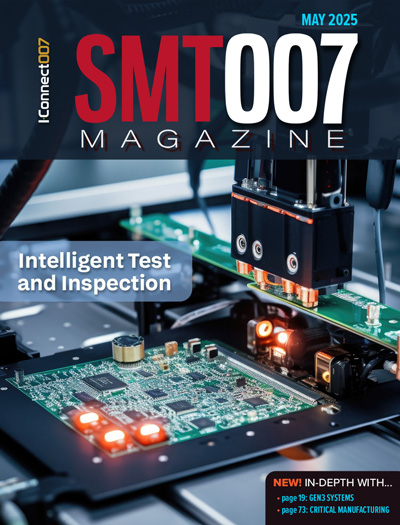-

-
News
News Highlights
- Books
Featured Books
- smt007 Magazine
Latest Issues
Current Issue
What's Your Sweet Spot?
Are you in a niche that’s growing or shrinking? Is it time to reassess and refocus? We spotlight companies thriving by redefining or reinforcing their niche. What are their insights?

Moving Forward With Confidence
In this issue, we focus on sales and quoting, workforce training, new IPC leadership in the U.S. and Canada, the effects of tariffs, CFX standards, and much more—all designed to provide perspective as you move through the cloud bank of today's shifting economic market.

Intelligent Test and Inspection
Are you ready to explore the cutting-edge advancements shaping the electronics manufacturing industry? The May 2025 issue of SMT007 Magazine is packed with insights, innovations, and expert perspectives that you won’t want to miss.
- Articles
- Columns
- Links
- Media kit
||| MENU - smt007 Magazine
Lead-free Process Control Management
December 31, 1969 |Estimated reading time: 8 minutes
In past pursuits of RoHS compliance, manufacturers focused on process changes, solder chemistries, and equipment. Now that the lead-free process is defined and better understood, factory operations must direct attention toward the ability to support changes and provide a means to control and Ensure compliance. This article explores the challenges of the lead-free transition related to shop-floor materials, process control, and traceability.
By Bob Miklosey
Because lead-free processes are better defined and understood, factory operations must direct attention toward the ability to support needed changes, and provide a way to control and ensure RoHS compliance. Are products lead-free in content as specified? Have they experienced the proper thermal cycles? It is critical for operators, especially factories using both leaded and lead-free simultaneously, to be able to ensure the proper materials are at the right location at the right time. This article illustrates how solutions can be achieved through process-wide, machine-integrated manufacturing execution systems (MES) solutions with shop-floor materials control.
Current Circumstances
Most companies have used a strategy to isolate leaded and lead-free assembly processes. Common methods include dedicating assembly lines or workstations for a specific methodology, grouping workflow for a given time period, segregating the material, and/or identifying shop-floor personnel with different colored outfits to designate the process they support. However, in all of these cases, the real world dictates greater flexibility to accommodate the demands of the customer - whether internal or external. For example, a disproportionate amount of process work may require overflow work to be built on another line, an individual’s expertise may require them to assist in the other process, or management directives to satisfy a given build-order may force the other process to be wedged into the scheduled work for that day. In all of these cases, the organization’s strategy is compromised and allows for the possibility of contamination between processes and their required material.
 Figure 1. Process-wide MES system with materials-control capability and real-time data collection validates and controls all process steps.
Figure 1. Process-wide MES system with materials-control capability and real-time data collection validates and controls all process steps.
All manufacturing plants are vulnerable to contamination. Let’s follow the steps in which an unplanned order has reached immediate build priority and should require a change to a different solder process:
The affected line has been building products using a tin/lead process throughout the day. Late in the shift, the line supervisor is advised that a lead-free assembly must be built on this line. Although unintentional, this is not communicated clearly to shop-floor operators. The operator at the paste application step fails to switch to a lead-free SAC solder paste chemistry. Meanwhile, automated placement machine operators performing feeder changeovers load component reels from manufacturers with tin/lead-tinned leads. At the reflow oven, the recipe is not refreshed because the loaded profile works well for this type of board. At the hand soldering station, the operator continues to use tin/lead wire chemistry; however, someone hopefully has realized the mistake by now. By then, one or more of these mistakes were made at a great cost to a critical order.
While the above example exaggerates potential disasters using some obvious circumstances, it is the subtle changes that are not as easily controlled and detected. Examples of this include:
• The board may have both leaded and lead-free existences, but the stencil is different due to aperture layouts.
• The product’s component mix places demand on the reflow process where thermal levels are at the fringe of acceptable levels.
• The board ends up at a necessary routing step, but is supported by the other process.
• A deviation to the process is required, but not communicated effectively to the shop floor.
Fortunately, all of these circumstances (whether obvious or subtle) can be controlled through MES solutions, factory-wide in scope, process-detail granularity in depth, and with inherent circuit board product intelligence.
Intelligent MES-style Controls
Controls within an intelligent MES soluion begin in the factory office where new product introductions (NPIs) are prepared or a product is revised. The entire manufacturing process, including the steps before and after circuit board assembly, is intelligently defined to determine behaviors and controls that are triggered when the aforementioned circumstances occur. The part masters are also loaded in advance, along with links to supported customer, vendor, and manufacturer numbers.
For a given product, bill of materials (BOM) scrubbing is expedited and comparisons to prior revisions are performed. The component engineer identifies compatible internal part-number candidates for each line item in the BOM, as well as identifying items that are new to the plant. This engineer further scrutinizes potential internal part-number matches to the BOM by viewing the BOM’s approved manufacturer part number list (AML) simultaneously against a matching internal number’s AML. In cases where a manufacturer’s lead-free equivalent part number is changed slightly, such as by a suffix, wildcard searches are performed to confirm that assigned numbers are valid for the specific solder process. In parallel, process definition for the product begins. The responsible engineer assigns the BOM-level components across the manufacturing route, develops visually intensive work instructions, generates machine programs, and establishes bill of process (BOP) materials for each station where tooling, consumables, and BOM-oriented materials require setup validation.
Examples of a BOP include:
• Stencil, paste, and blades for stencil printers;
• Specific feeder types and assigned BOMs to specific pick locations for assembly machines;
• Specific fixtures and other applicable tooling for wave solder;
• Specific solder wire, other applicable tooling, and assigned BOM content for a hand soldering station; and
• Required tooling and assigned BOM content for box-systems-builds.
Responsible engineers also include the machine program and recipe files as attachments to this specific process definition to ensure its use on the equipment. Once the BOM is reconciled and the process definition is complete, these revisions enter into an automated approval cycle, which controls their accessibility to the shop floor. Upon subsequent approvals, the product is ready to run on the floor (Figure 1).
Executing Controls on the Shop Floor
Prior to running the job, automated controls are in place to assure the correct process is used and the correct material is assigned at each discrete work center. These controls guide operators through a standard setup process and relieve them from making decisions that can create problems that are amplified as the product continues downstream.
Using the same example where an unplanned build occurs, let’s begin at the paste application step:
The operator selects or scans an available work order in the MES. The system immediately prompts the operator that a material change is required to run this job, but they overlook this step and attempt to run a board into the machine through an upstream conveyor. The conveyor, outfitted with PLC-driven hardware connected to the SMEMA line and communicating with the MES, does not feed the board into the machine because the required material is not yet installed. The operator realizes this oversight and is guided to load the correct solder paste onto the printer. The operator confirms this action, either by scanning a barcode on the paste container or through a closed-loop mechanism using radio frequency identification (RFID) technology, and continues material-setup validation for the stencil and blades.
Continuing on to placement equipment, the same conditions exist. Products will not enter the machines until feeder changeovers are performed. Intelligent links between the pick-location ID and a feeder, a feeder and its loaded part, and the part and a unique inventory ID provided following clearance through incoming materials, verifies the pick location. As with the printer step, validation occurs through barcode scanning or a closed-loop method using RFID technology where each pick location is outfitted with its own RFID antenna.
At the reflow oven, the operator is prompted that deviations exist for this job’s reflow profile. This active prompting results in loading of the correct recipe, which was already retrieved as an attachment through the MES for this revision-controlled process.
At the hand soldering station, the assembler scans the board’s barcode and is actively notified that the product is to be soldered at the other hand soldering station where lead-free assembly is performed. Once re-routed properly, the assembler performs material-setup validation by scanning the components loaded into each bin, as well as the proper solder wire used for this board.
Controls to Acquisition
Beyond executing controls on the shop floor, which assure a product is ready to run down an assembly line, data is collected from both the automated equipment, as well as operators. The collected data is harvested by the same MES, providing for real-time reaction to issues that are reaching, or may already be out of, the control limits. Data is collected from production equipment to automated optical inspection (AOI), in-circuit test (ICT), and functional circuit test (FCT) equipment. From this broad scope of data acquisition, the intelligent MES provides immediate reaction in a variety of ways. Responsible engineers and/or managers are notified through e-mail; a shop floor supervisor is prompted with a message on the screen; and in the most severe conditions, the production line is halted using product-flow controllers. An example of this is automated data collection from an oven monitor in which the allowable peak temperature or dwell time is exceeded. The system reacts according to behaviors previously defined by the responsible engineer, and provides notification that operators can readily understand.
By-product of Control and Data Acquisition: Traceability
All actions performed on the manufacturing floor are recognized through a true MES; from a given product’s development on the shop floor; and through assembly, inspection, test, system-build, pack-out, and return material authorization (RMA). As a result, all of these actions, whether from automated data acquisition or through operator entry, are available in a comprehensive form for the product’s life. Most importantly, this record of assembly is proof that the product was built against the correct paste chemistry in an accurate manner, even if corrections were required. While initiatives such as RoHS may not clearly state explicit proof, it is inevitable that this will become a requirement in this age of information, where knowledge in respect to data depth and scope are ever increasing. For manufacturers, traceability of this magnitude instills greater levels of confidence to the customer, and at a minimum, may prove them least guilty of a potential problem occurring in the field.
Conclusion
The circuit board assembly industry is in the midst of a monumental transition between historical and regulatory-driven processes. With this transition comes process variability and material compatibility issues that did not exist previously, and now require intelligent controls. Manufacturing execution systems are commercially available to cover the entire manufacturing process, and provide setup controls, real-time reaction, and product traceability details to assure operation of the highest possible product quality levels.
Bob Miklosey, vice president of product management, Aegis Industrial Software Corporation, may be contacted via e-mail: bmiklosey@aiscorp.com.


